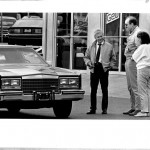American dining has a cultural crisis looming on the horizon. Partially it is based on our weak-kneed economy which pushes many of these establishments to the edge of failure, so far away from profitability as to be sorrowfully laughable. Beyond the weak economy, American restaurants have a distinct series of problems that they really have to face.
The first issue with the American dining experience that strikes me immediately is that many restaurants that attempt to create a valuable dining atmosphere by dimming the house lights. The idea runs that if the lights are subdued then people will see it as romantic and attach those warm feelings to the place where they dine. In America, this is a problem because what is seen as good if you take it only so far is seen as much better if you take it way too far. Many restauranteurs have said time and time again that people eat first with their eyes. To see food is the first step in creating a lasting impression on your customers. In America the lights are so dim that it is nearly impossible for someone with 20/20 vision to clearly read 10-point text that is being held in their own hands. The lighting in these establishments is dimmed to the point of unpleasantness. You can’t really see who you are dining with, the food looks muddy and dull and the entire experience is one of tragedy. As an example of this, I just dined at an establishment, which shall remain nameless, in which the house lighting was so poor that I needed my smartphone’s illumination to read text on a card that I had in my own hands. When the food was delivered the lighting was barely enough to identify what was on my plate. It was the first step in a very unsatisfying evening. So, what’s the advice that I have for restaurant hosts? Turn up your house lights. If you are hiding in the dark then we can conclude one of these situations may be true:
- The food is ugly, and so it’s dark to protect your mistakes.
- The host is ugly, and so it’s dark to protect your feelings.
- The guests are ugly, and so it’s dark to protect other guests feelings.
- The decor in the establishment is ugly, and so it’s dark to cover the decorating transgressions.
The upshot is, when it’s too dark to read words on paper, when your guests are using their phones to find their food, then there is either something wrong with ugly or you are just trying too hard to amplify romance and have landed directly in the dimly lit antechamber of hell, a place that is referred to as heck. Many American restaurants have embraced heck to such passionate levels as to take the breath away. This is a shame, because in many of these establishments the only way you can navigate is with echolocation, so not having the sound of your breath bouncing off obstacles is a true peril for the diner.
The next issue has to do with communication. In this regard, there is way too much communication in the American dining experience. The procedure is always like running the gauntlet, the host is often nervous and like Mrs. Peacock they suffer from a pressure of speech. They arrive tableside and disgorge in an effluent of chatter. You cannot engage in a conversation because you are constantly being interrupted by a curious host who, wrapped up in good intentions is obsessed with making sure that everything is running smoothly. This has infantilized American diners. We can’t operate our dining experience without a chatty, clucking, obsessive hen buzzing the table every 2 minutes. Even here American restauranteurs make tragic mistakes, especially when it comes to effusive apologies. The protestations of sorrow from some hosts fly so fast and so thick that you often times wish they would just get a gun, load every chamber, point it at their heads and pull the trigger. If you are so sorry, then die for it. If you aren’t, then shut up. Some hosts just cannot leave well enough alone. That’s why in America dining is an olympic speed sport. How fast can you choke down the food? You have to because to endure dining is running a verbal gauntlet and since you cannot have a cogent conversation with a solid train of thought while you dine, it’s more advantageous to skip real conversation and switch to smalltalk which entertains nobody. All that is left is the food. In the dark. With perhaps an ugly host, you can’t be sure.
What is to be done about this problem? American restauranteurs need to take a page from the French way of dining. Collect the order, then silently orbit the dining room, spotting low beverages, spotting soiled napkins, that sort of thing. Be conscientious enough to spot silently and silently tend to what needs tending. If the diners wish to engage in an interruptive exchange they should be the ones to initiate contact. A fussing clucking chattery mother hen would have alienated every french diner in the restaurant. There is something here that bears to be understood. Keep your chattery teeth to yourself.
Then we get to the food, which begs the ancillary point of pricing. If you are going to cast yourself as destination dining, produce output that is worthy of your aim. Here’s an example – I just dined on a plate of chicken, green beans, and potatoes in a butter sauce for $18.00. There were three small strips of chicken, I would classify the cut as “chicken strips”. There was a small woman’s palmful of green beans and three 1-ounce scoops of potatoes. There was about two ounces of sauce. This was not a meal. This was 40% of a meal. To say I felt robbed was an understatement. Four diners, three with an appetizer course, 4 mains, and 1 dessert split three ways – I declined the appetizers as none of them suited me and I didn’t find the dessert choices appealing enough to partake. The table bill came to $128.00, we were two couples, split that bill in half and with tax and a standard tip of 15% my outlay for dinner was $76.00. What did I get for that money? I got very little. Scott got slightly more, but had to bark the cook into cooking his duck breast as the standard fare is apparently rare duck, which might as well be raw chicken for a health aspect to it. It boggles the mind. So, when you are busy charging your customers outrageous prices for fussy cuisine which does not match value for price, tread carefully when complaining to said customers about how little business you get to walk in the doors because of the prices.
What should restauranteurs do? I heartily suggest ripping a page out of the Gordon Ramsay playbook: Keep your food local, fresh, simply cooked, for fair prices and you will be a success. Deviate from that plan even in one spot, like obnoxious pricing for example, and you will alienate your customers.
So here I sit. I’ve paid a restaurant bill of $76 dollars and I’m going to go to bed hungry. I will never go back to that restaurant again, once bitten twice shy. As I was discussing it with Scott, this is the cost of the lesson to decline such dining experiences in the future. I just don’t have the wherewithal to financially support such endeavors. I can only hope that some people who run restaurants read this and take these bits of advice to heart. Turn on the lights, shut the hell up, and stop charging an arm and a leg for what amounts to being a pittance.
 I sent three old iPhone 4’s to e-Cycle for recycling, they had a relatively good buy-back rate for the old devices. Of the three that I sent, only one was accepted. The other two were shredded and I got nothing for them, other than the vague satisfaction that the hazardous materials in them were recycled, probably.
I sent three old iPhone 4’s to e-Cycle for recycling, they had a relatively good buy-back rate for the old devices. Of the three that I sent, only one was accepted. The other two were shredded and I got nothing for them, other than the vague satisfaction that the hazardous materials in them were recycled, probably.
